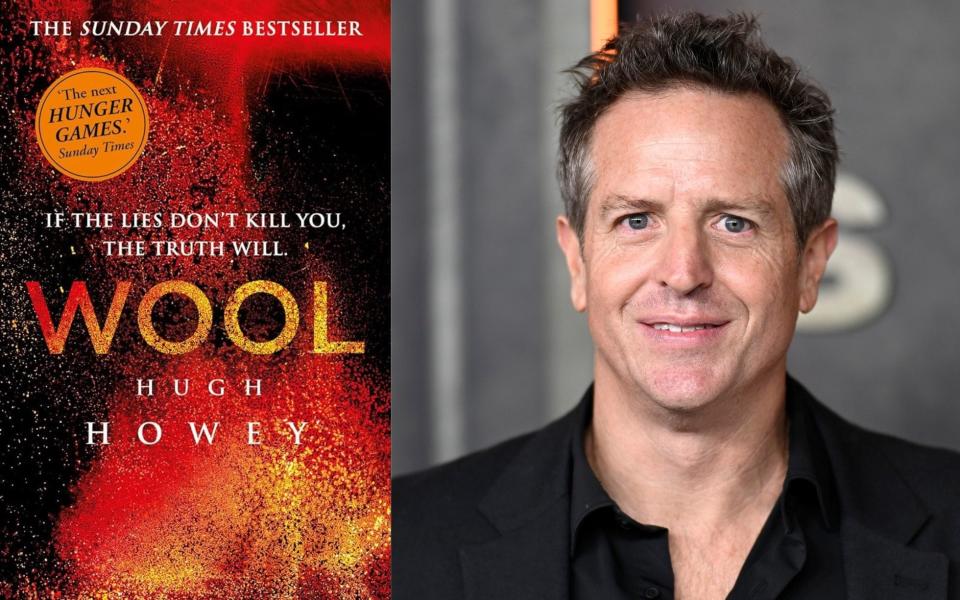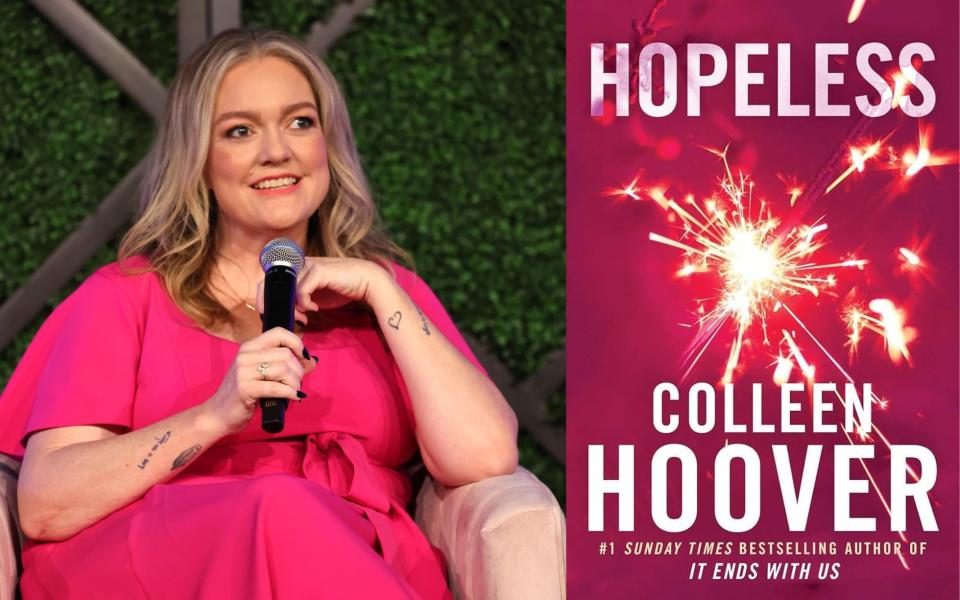No publisher, no problem: the authors earning a fortune by going it alone

In 2012, the American dystopian fiction writer Hugh Howey entered the rarefied ecosystem of blockbusting authors when his book Wool began selling in numbers that netted him a monthly salary of $150,000. More remarkable still was that this modest compendium, comprising a short story and four novellas, was a self-published title available only in electronic form.
In an industry in which 90 per cent of books sell fewer than 2,000 copies, the benefits of Howey’s decision not to sell his words to an established company – a Hodder & Stoughton, say, or a MacMillan – were two-fold: he made far more money on each sale while also retaining control of his own copyright. Last year, under the title Silo, Wool became a 10-part series on Apple TV. A second season is in the pipeline. Talk about making your own weather.
“I laugh at the people who say writers can’t afford to put a professional book together,” he told the Writers & Artists website, in 2013. “I spent a lot more money playing video games than I do investing in my work. My wife spent more money gardening. You have to look at this as a hobby, but one with the potential to pay you back. So, yeah, save up and invest in your work. Pay yourself a dollar for every 500 words you write. Set that aside and you’ll have enough to publish your book when you’re done with it.”
More than a decade later, it has never been easier to publish your own work. By my estimation, there are about 10 major self-publishing platforms, of which Amazon, who issue titles in both electronic and printed form, are the leading player. Other companies include Apple, Kindle Direct Publishing, Lulu and Smashwords. All you do is send in your manuscript (formatted to technical specifications and sometimes, but not always, edited and proofread by freelance professionals).
In other words, in the 21st century, aspiring authors no longer need to write a 10,000-word proposal in order to whet the appetite of a commissioning editor at a traditional publishing house. According to Howey, increased opportunities in the independent sector mean that “many successful self-published authors have moved away from traditional publishers to go it on their own. Many don’t even try that route. [Increasingly] publishers will have to compete for manuscripts by offering better services, like monthly payments, better royalties, lower e-book prices, and a myriad of things they’d prefer not to do.”

I fear these creator-friendly uplands might be some way off. It’s worth noting, I think, that first-time writers lacking representation by a literary agent often face a torrid time when it comes to getting a book into print via conventional routes. (It’s hard enough for established authors, although that’s another story.) In less than flattering lingo, unsolicited manuscripts are known in the trade as “churn”. I once visited an agent’s office in which sat an employee whose job it was to cast an eye over such submissions. In the three hours I was there, she ploughed through dozens of them. Each one was discarded.
Of course, rookie writers with formal deals can become literary sensations. Two years after JK Rowling signed with Bloomsbury for just £2500, Harry Potter And The Philosopher’s Stone took barely two years to make it into the home of 300,000 British readers – not bad for a title with an initial print run of just 500 copies. By the same token, though, self-published works can also make a major splash. The list of bestselling books by fully independent authors includes Fifty Shades Of Grey, The Martian, The Revolution Was Televised, The Rabbit Who Wants To Fall Asleep, and many more.
Twelve years after Colleen Hoover became the first DIY writer to earn a spot on the New York Times bestseller list with her book Hopeless, the hits keep coming. In 2022, as part of an online fund-raiser for the Dragonsteel series, the fantasy author Brandon Sanderson raised a whopping $15.4 million in just 24 hours. Elsewhere, authors who made their name in the formal scene are themselves beginning to take advantage of the freedoms offered in the world of self-publishing. In 2021, Salman Rushdie serialised his novella The Seventh Wave on the newsletter site Substack. In the same year, Chuck Palahniuk issued his own novel, Greener Pastures, on the same platform.

Out in the wild, the most successful independent authors tend to be those who have got the hang of self-promotion. While some are able to afford online marketing in the form of pop-up adverts and the like, others have harvested rich pickings without spending a penny. In particular, BookTok, a sub-committee of TikTok, has revolutionised the art of the hustle, with writers such as Rebecca Yarros and Carley Fortune selling hundreds of thousands of copies on the strength of short videos.
Keila Shaheen, a self-help author from Texas, sold more than a million copies of her book The Shadow Work Journal when TikTok influencers got hold of it - many of them through TikTok’s own shop. And in 2023, the daughter of Lloyd Devereux Richards posted a TikTok video persuading potential readers to give her dad’s self-published 2012 thriller Stone Maidens a shot – he had spent 14 years writing it and sales weren’t great. The video was viewed over 57 million times and rocket-boosted sales.
As a whole, though, the emerging demographic of sole traders are racking impressive numbers. According to the Wordsrated website’s Self-Published Books & Authors’ Sales Statistic report, between 30 and 34 per cent of e-books bought in 2023 were self-published. Sales numbers of 300 million represent a 264 per cent rise in the number of equivalent titles sold in 2019. Of these, the genres of romance, fantasy and crime-slash-thriller dominate the field. Unlike traditional publishing, there’s no glass ceiling in this open-to-all market either. Of the best-selling independent e-books from last year, 67 per cent were written by women, compared to 39 per cent of titles issued by the formal arm of the industry.
In the opinion of Martin Reed, the Head of Communication at the writers’ trade union the Society of Authors, self-publishing has now become “a mainstream route to getting your book in front of an audience. For many, many authors, it’s their first choice,” he says. “And for many of our longer-standing members who’ve got a catalogue of [past] books that their publishers are just not pushing any more, it’s becoming increasingly common for them to claim their rights back from their publishers and then self-publish them.”
With self-published authors reaping royalty rates of up to 70 per cent for each sale, clearly, there is money to be made. Despite the top one percent of independent authors trousering 31 per cent of revenues, according to a report by the Centre for the Regulation of the Creative Economy [CREATe], in 2022 the median annual salary across the sector was $12,755 (an increase of 50 per cent on the year before). This sum, I note, is about £3000 per year higher than the equivalent figure for British authors whose books are published by established literary imprints. As it so happens, I fall into the latter camp.
If you detect a measure of surprise in my voice, it’s because I’m just about old enough to recall a time when self-publishing – or “vanity publishing,” as it was once known – was about as reputable as pornography. In fact, some of it was pornography. Enticed by small adverts in the back of newspapers, aspiring authors were able to realise their dream of seeing a manuscript traditional publishers wouldn’t touch with a javelin transformed into a book. For this privilege, all they had to do was pay a handsome fee and surrender their copyright. According to Martin Reed, even now, the unpublished person of letters should continue to keep ‘em peeled – these firms do still exist.
These sharp practices remind me of the novel The Information, by Martin Amis, in which the protagonist works part-time at a vanity press that’s printing up a title by an author who claims the guards in World War II concentration camps were Jewish while the captives were innocent Germans. Then there’s Mark Corrigan, a lead character in Peep Show, who pays to have his own work, Business Secrets Of The Pharaohs, issued by a self-publishing firm (run by a man who works from a desk in a garage) that spells his name wrong on the front cover.
In foregoing the services and hurdles of the formal industry, though, many authors savour the independence of going it alone. After shopping his excellent novel Village Kids to publishers and agents, without success, for 12 months, Alistair Lawrence decided to join the self-publishing scene by issuing the book in printed and electronic form through Amazon. So far sales have been modest, although I think it’s worth noting that creative writing isn’t a dairy product – there’s no expiration date on unexpected success. Lawrence also spared himself many months of the kind of anxiety that comes with working with established literary houses who have far less to lose than the authors they publish.

“By self-publishing, I had more control,” he tells me. “If something went wrong, I had the ability to try and rectify that. I’ve heard countless horror stories from author friends about traditional publishers being at best complacent and at worst incompetent, all of which harmed the promotion of their books.” As well as taking advice from professional editors, when it came to buffing the words on the page, Lawrence also hired a copyeditor and a proof-reader. “Not having that feedback loop when you’re just starting out might have made things more difficult,” he says.
He’s got that right. As matters relate to my own book (Bodies: Life & Death In Music, published by Faber & Faber), it was only the keen eye of expert copyeditor Ian Preece that prevented my precious creation from being, at least in part, a piece of junk. After being royally told off for my repetitions and thematic cul-de-sacs, a sleep-starved month in which I redrafted and rewrote vast chunks of a text I had believed to be unimpeachably perfect saved me from enduring shame. I did the work, sure, but the idea that I might have gone it alone without help discerning wood from trees (as many fully independent authors do, and likely I would too) gives me the sweats.
With self-publishing open to all, to put it softly, quality control is not much of a consideration. Emerging platforms will issue the kind of book written by Jack Torrance, in The Shining, in which the phrase “all work and no play makes Jack a dull boy” is repeated over and over again for hundreds of pages. Conscientious writers should also be aware of rip-off merchants offering editing, cover-design and typesetting services. “There are a lot of scurrilous [people] out there looking to make a dime from authors who are desperate to find readers,” Martin Reed tells me. He recommends the Writer Beware website for anyone seeking to navigate this minefield.
In other less than good news, perhaps inevitably, the world of self-publishing is also on the frontline of titles that aren’t created by real people at all. A glance at YouTube, for example, reveals dozens of tutorials for anyone who fancies generating colouring books using Artificial Intelligence. And if you want prose, no problem. Last year, the former BBC tech journalist Rory Cellan-Jones discovered that AI had somehow coughed up an autobiography in his name. I don’t imagine the book being recommended to him by Amazon did much to sweeten the news.
“While scam books have existed almost as long as publishing and online booksellers have had to combat the phenomenon, generative artificial intelligence presents uncharted territory,” Jane Friedman, the co-founder of the e-book company Open Road Integrated Media, told Bloomberg Law after discovering the existence of AI books under her name on Amazon. “People can now use the tool to almost instantly produce large swaths of text in the writing style of existing authors—and list them for sale.”
Call me pessimistic, but sooner or later the advent of artificial intelligence will herald a reckoning in the book trade. Technology and the profit motive will out. In a worst case scenario, authors such as myself will perhaps be required to shed our reservations – our snobbery, perhaps – about the opportunities offered by the models of self-publishing.
After all, as Alistair Lawrence says, “most readers don’t care where their art and literature comes from any more. They only want it to be good.”
Village Kids by Alistair Lawrence is available on Amazon

 Yahoo News
Yahoo News 
